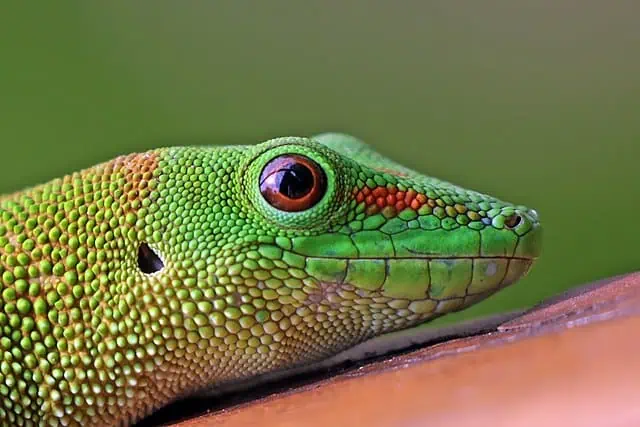Giant Day Geckos are the largest day geckos and an adult can reach a foot in length. They typically last around 15 years in captivity and they make excellent pets. They are very beautiful and very interesting to observe. These geckos are well-muscled and thick-bodied as well.
In this article, we’ll talk about the diet of a Giant Day Gecko and what you can do to ensure it lives a long and happy life.
What can a Giant Day Gecko Eat? Diet Tips
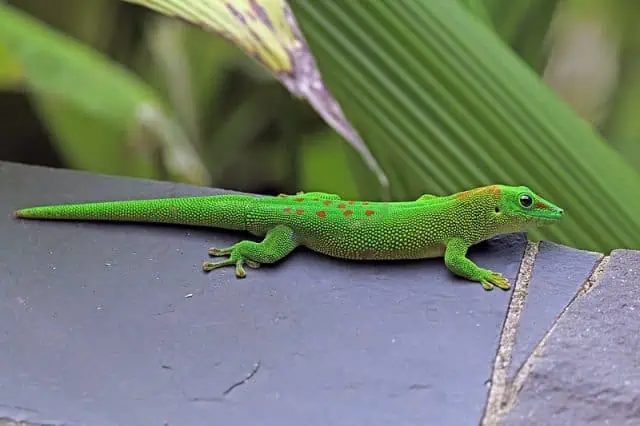
Giant Day Geckos are some of the easiest geckos to maintain when it comes to feeding. They’re never pretentious and they eat a very wide range of insects, fruits, vegetables, and greens. This makes home-growing everything your gecko needs very easy, but finding a good supplier is also not hard to do as their dietary needs are pretty basic.
Up to 5 days a week you need to provide your Giant Day Gecko with insects. This is because their main food is still insects and they are preferred alive as well. If you give a Giant Day Gecko a dead gecko it might not eat it or even bother to check it out. They’ll see it as spoiled food and they will start looking around for moving insects.
One of the main insects you can feed your gecko is none other than the cricket. But they also eat roaches and soldier fly larva. Then you need to provide some fruits up to 4 days a week, which is another big part of a Giant Day Gecko’s diet. You can feed the gecko mangos, oranges, kiwis, blueberries, etc.
Vegetables and greens are also a must and they should be offered 3 days a week. This includes escarole, dandelion, okra, carrot, butternut squash, hibiscus flower, etc. Then you’ll have to make sure that you’re dusting two of the meals a week with calcium powder and one meal a week with a vitamin powder.
However, you should keep in mind that these are just some guiding tips and that you’ll get better at feeding your gecko a varied diet as time passes. You can even feed a mix of foods for one week, then change to a different mix of foods for the next week. This will keep the gecko interested in its food and you won’t have to deal with skipped meals.
You will naturally have a hard time beginning to feed your gecko when you first get it. It might even go up to two or even three weeks without eating anything. And all you can do is keep placing food in its enclosure and pick the uneaten pieces out of the cage. This happens because geckos get stressed out when you change their environment and they take a while to feel at home again.
But if you had the gecko for a while and it suddenly stops eating, it’s highly recommended to go to the vet and make sure there’s nothing wrong with your Giant Day Gecko.
Can they eat insects? What kind are better? How do you gut-load them?
Giant Day Geckos need various types of insects to lead a happy and healthy life. But it’s very important to keep in mind that the insects should always be smaller than the space between the eyes of the gecko. This refers to the width of the insect, not the length. The insects should also be alive when placed inside the gecko’s enclosure.
Crickets are found in almost any gecko’s diet as they’re very high in nutrients and pretty low in fat. You can find lots of species available as crickets can be found almost anywhere in the world. They’re excellent for day geckos as they’re pretty big and won’t have any trouble eating these insects. And if buying them seems a bit too expensive, you can always breed and keep your own crickets.
Breeding and keeping crickets is not very difficult but it takes a bit of experience at first. This is because they’re known to be very good at escaping and you don’t want a loud and hard-to-catch cricket making noise around your home all the time. Their jaws are pretty strong as well and you need to be careful as they’re known to bite humans.
When it comes to roaches, the dubia roach is easily one of the most recommended feeder insects for geckos. They’re almost as high in nutrients as crickets and they’re easy to gut load. But you should check if you’re allowed to get them in your state as they’re considered an invasive species. Most geckos find these roaches very tasty so you can feed them to stubborn eaters as well.
These roaches are also very easy to breed and keep as they can’t climb on any smooth surface or jump around. They’re also moving very slowly and they typically don’t fly. More than that, they’re not as noisy as crickets so you can keep them in peace. And another great thing is that they require a tropical environment to live in, which is why they won’t establish in your home if they escape.
Black soldier fly larvae are very popular as a feeder insect as well. This is because the black soldier flies reach their nutritional peak at their pupal stage. They’re excellent for Giant Day Geckos and you can offer them to your gecko on a plate. You can also feed your gecko adult black soldier flies, although they’re not as nutritious. You will also notice that lizards catch some house flies that get into their cages as well.
They’re also convenient as you can store the black soldier fly larvae at room temperature and they can last for several weeks. It’s important to keep in mind that the longest shelf life is achieved when the temperature is maintained between 50F and 60F.
When it comes to the insects you can use as treats, you should only offer one or two a week to your Giant Day Gecko. This is because you should also give your gecko a slice or two of fruit and a piece of veggie once or twice a week.
Mealworms are extremely common as either regular food for geckos or as treats. You should only use them as regular food if the gecko you have doesn’t gain weight too fast. But since Giant Day Geckos tend to go overweight pretty fast, which means you should only use mealworms as an occasional treat. They’re high in protein but they’re also high in fat.
There’s no need to bother to breed and keep mealworms at home as they’re commercially available all over the world. You can get them in bulk and they generally come in containers that also contain oatmeal or bran as food. More than that, the ones bought are bigger as commercial growers put a juvenile hormone into the feeding process to maintain the mealworm in its larval stage.
Superworms are as popular as mealworms when it comes to gecko treats as they’re quite high in protein and fat. And while they’re used as regular food for many geckos, your Giant Day Gecko should only get it as an occasional treat so it won’t gain weight.
More than that, superworms are also widely commercially available and they can also stay alive for up to 1-2 weeks without eating. This makes them very convenient as they will last for a long time. But unlike mealworms, they don’t enter a process of hibernation and they need to be kept at warmer temperatures. You should also be careful when handling them as they’re known to bite when they feel threatened.
Waxworms are a delicacy to geckos and they’re very often used to get stubborn eaters to start eating. They’re also great at luring the gecko out of its hiding spot and get it to spend some time with you. These waxworms contain a very high amount of fat and their calorie density can contribute to obesity if fed as regular food or even as regular treats. One a week is already too much for a Giant Day Gecko.
Are fruits OK?
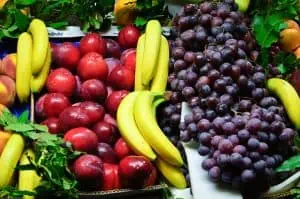
Fruits are also a very important part of a Giant Day Gecko’s diet. But you need to keep in mind that the fruits these geckos eat in the wild and the ones you get from the store can be very different. The ones we find in stores are considered “domesticated” fruits and their nutritional content differs a lot from their wild counterparts. More than that, the domesticated fruits are very high in sugar.
In the wild, Giant Day Geckos will eat nectar and pollen, which they will get from the insects. But in captivity, feeding the gecko small slices of fruit or a puree mix is a much better idea. You should always include some type of food in the gecko’s regular food, but you should also offer a piece as a treat as well. If your gecko has one specific fruit that it absolutely loves, use that fruit as a treat.
Fruit treats are a great way of bonding with your gecko as well. They might also help you get the gecko out of its hiding spot so you can spend some time together. But you need to be extremely careful when handling a Giant Day Gecko. First of all, it can lose its tail when it’s feeling threatened, and second of all, it has a very sensitive skin.
You might end up with green palms and various patches of skin on your hands if you’re handling the Giant Day Gecko inappropriately. Use the gecko’s favorite fruit to lure it out but make sure you’re as gentle with it as possible as it might take a little while before you two will become friends.
Giving your gecko garden fruits (such as pears, strawberries, watermelon, etc) might not be good enough as these fruits are low in nutrients and high in sugar. But tropical fruits are a bit better, despite also being much sweeter than the wild fruits. Just make sure you’re not feeding too many fruits and your gecko should be safe from any problems.
When it comes to feeding the fruits, it all depends on how your gecko prefers them. Some geckos love thin slices of fruits that they can eat off a plate. While other geckos love puree mixes and they’re also easier to digest. You can also mix some fruit-flavored baby food as geckos typically love baby food and is a great thing to add to their fruit smoothies.
Some of the most recommended fruits for your Giant Day Gecko are mango, papaya, pineapple, oranges, kiwi, guava, figs, dates, cantaloupe, berries, etc.
Can you give them vegetables?
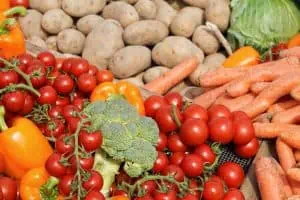
Besides insects and fruits, Giant Day Geckos also need a few vegetables incorporated into their diet. And since their diet is so varied, you don’t have to grow your own vegetables. However, getting them from someone that grows them at home is a much better idea than feeding store-bought veggies to your gecko. And if you already have your own little garden, you can control how healthy the vegetables will be in the end.
Vegetables are the part of the diet that brings in various nutrients and lots of beta-carotene. You know the vegetables are good when they are bright in color and not too high in phosphorous and oxalates. And the surprising thing is that sometimes the healthiest foods for your geckos are also the strangest ones. This includes hibiscus flowers.
The reason why vegetables are highly recommended is that they help replace the pollen Giant Day Geckos typically eat in the wilderness. More than that, vegetables have lots of nutrients and low levels of sugar, unlike fruits, which is also the same role that pollen plays in their diet. And if you only have a single gecko, you might not have to grow or breed anything at home as the gecko’s food is not very pricey.
When it comes to feeding the gecko the vegetables it’s the same thing as with the fruits. A few geckos might prefer extremely thin slices of veggies, while most geckos would prefer a puree mix. And it’s even better if you give your gecko its fruits and veggies at the same time so you can mix them up in the same puree, plus a little bit of baby food. You might also need to add a bit of calcium and vitamin powder.
The best vegetables that should always be on your list are pumpkin, acorn squash, okra, butternut squash, common button mushroom, bell peppers, hibiscus, and prickly per leafs. These vegetables are loved by Giant Day Geckos and they contain most of the nutrients that they would also get from the vegetables they would typically eat in the wild.
Besides the ones mentioned above, you can also include other more traditional vegetables, such as cucumber, asparagus, broccoli, brussel sprouts, snap peas, tomatoes, carrots, green beans, etc. These are also a good addition to a Giant Day Gecko’s diet but only in small portions.
Greens are another very powerful source of nutrition for these geckos and they should be included in their diet. This is because they contain more vitamins, calcium, and other minerals than most vegetables. Small amounts should be offered to the gecko around three days a week. While greens are important, they still play a smaller role in a Giant Day Gecko’s diet than insects, fruits, and vegetables.
A good green for your gecko should be rich in calcium, low in phosphorous, and also low in anti-nutrients, such as oxalates and goitrogens. And these geckos typically like eating them in a smoothie that’s also blended with their favorite fruits.
The most recommended greens are endive, escarole, alfalfa, and dandelion greens. A few other good options are also bok choy, mustard greens, collard greens, turnip greens, and watercress.
Should you give them supplements?
Supplements are still a controversial topic among gecko keepers as many point out that they wouldn’t have access to supplements in the wild and that they are doing fine without them. And while this is true, being fine is a completely different thing than thriving and living a completely healthy life. If you have the possibility, you should make sure your gecko gets everything it needs, even if it might have been deprived of it in its natural habitat.
Vitamin/Mineral supplements are very important as their job is to make sure no nutrients are missing when you’re feeding your gecko. But since there’s such a wide range of supplements on the market, it’s important to find the right supplement for your gecko. And to find the right supplement you just need to take into consideration a few key nutrients.
Most veggies and fruits are low in iodine, iron, and magnesium. This means you should look for a supplement that provides these nutrients, along with good amounts of B vitamins. You can tell the supplement has iodide if it contains kelp as an ingredient.
More than that, Vitamin A should be provided in a retinol form. This is because it’s not known if Giant Day Geckos can synthesize vitamin A retinol from beta-carotene. Dust the meal of these geckos with a Vitamin/Mineral supplement once a week.
Calcium is also very important for geckos and it should be supplied to your gecko in a combination with UVB lights. A calcium supplement should be used in gut loading the insects and to dust them right before they’re being eaten by the gecko. Giant Day Geckos need a lot of calcium, which means you need to dust the meals for two days a week.
The reason why UVB light is a must when dusting the gecko’s food with supplements is that geckos don’t have the necessary vitamin D to process the calcium.
Is commercial food available for Day Geckos?
Commercial food has gotten a lot better over the years and some geckos can actually live only on commercial food and lead a happy life. Unfortunately, Giant Day Geckos are not among these geckos. And while there are many premixes designed specifically for Giant Day Geckos, they will often not accept them.
And since you might end up wasting your money on commercial food, it’s not recommended to try it. But if you do, make sure it’s high quality and that it includes everything your gecko needs. These premixes are typically mixed with a little bit of water and are fed on a low plate. They also harden the next day so make sure to remove any uneaten food.
A great replacement for these mixes is baby food and it can be used either as a treat or as regular food.
How often do you feed a giant day gecko?
Adult giant day geckos need to be fed an insect diet 2-3 times a week and fruits, vegetables, and greens on the rest of the days. Juveniles need to be fed once every 2 days or so and hatchlings always eat a few times a day. As the gecko gets older, you need to feed it bigger insects at shorter intervals of time.
But you should keep in mind that these dietary guidelines are made so you can make an idea of what your gecko needs. You will have to plan your Giant Day Gecko’s diet plan together with your vet to ensure the gecko is getting everything it needs.
Water Requirements – How much and how often does it need to be changed?
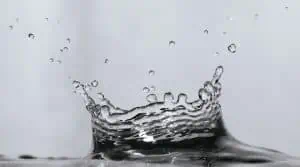
Giant Day Geckos need a bowl of fresh water in their enclosure at all times. The water needs to be natural and without any chemicals that get rid of contaminants as these chemicals also destroy some important minerals. Bottled water (that doesn’t come from a tap) is the best water to offer your gecko. More than that, the same water should be used for misting the enclosure.
Geckos don’t typically drink from the bowl as they usually drink the water droplets that have gathered on the leaves. But it’s still important to provide clean water as it can still drink from the bowl. It’s also very common to see a gecko inside the water bowl soaking.

